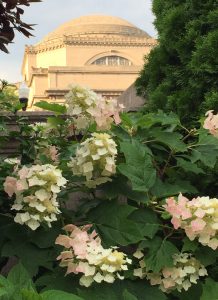In the #WeMissLow series, we’ve talked about the Low Library building as a library, the home of the administration, a ceremonial gathering place, a film location, and even an athletics training facility. In this post, we offer a Low Library reimagined.

In 1973, University Architect Dean Telfer sent a memo to incoming University President William McGill concerning the Future Use of Low Library. In the memo, Telfer first proposed moving the administrative offices to the third floor of Low Library, “President Butler’s old rooms.” There were more offices on the higher floor than on the second or main floor. The higher floor would also provide additional security and contiguity for the offices. This was a sensible proposal: more office space and with a presidential precedent.
In the same memo, Telfer offered a second, more radical and intriguing plan. According to Telfer, Low Library was a “grand centerpiece.” It was “central, pivotal and dominant, not only physically, but also to the sense of being at Columbia.” However, he argued that Low Library now appeared “ponderous, remote and authoritarian” and that it “exemplif[ied] our separation from the Deans, schools, and students.” A new administration could change all of that by moving the administrative offices out of Low Library: “The building should not be an obstacle which students and faculty negotiate their way around every day. The main entrance steps ought to welcome people in regularly” and should be “where the interesting activity is.” He argued that Low “should be the public forum of the university” and that departments should “be invited to give the courses there by which they would wish their department to be known.” The administrative offices, in turn, would switch spaces with the departments in Philosophy Hall. Telfer envisioned Low Library as a home for academic activity with a return of student traffic! One can only imagine . . .
(“Future Use of Low Library,” Memo to McGill from Dean Telfer, July 13, 1973. Central Files, Box 1150, “Renovation of 202 Low,” University Archives.)